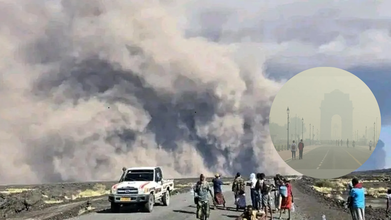- Health Conditions A-Z
- Health & Wellness
- Nutrition
- Fitness
- Health News
- Ayurveda
- Videos
- Medicine A-Z
- Parenting
Metformin, A Common Diabetes Medicine, Shows Surprising Brain Effects

Credits: Canva
According to the International Diabetes Federation, roughly one in nine adults worldwide lives with diabetes, and around 90% of these cases are type 2 diabetes. There is currently no cure for type 2 diabetes. Still, the condition can be managed through healthy lifestyle habits, such as staying active, as well as medication. One widely used medication is metformin, considered a first-line therapy for type 2 diabetes, and it has been prescribed for decades since the Food and Drug Administration (FDA) approved it in 1994. Recent research, however, suggests it may also act directly on the brain, opening the door to new approaches to treatment.
Metformin Found to Unexpectedly Affect The Brain
Scientists at Baylor College of Medicine in the US have discovered a brain pathway that metformin appears to influence, alongside its known effects on other parts of the body. "It has been widely believed that metformin lowers blood sugar mainly by reducing glucose production in the liver. Other studies have also highlighted its action in the gut," says Makoto Fukuda, a pathophysiologist at Baylor.
As reported by Science Alert, the researchers explained, "We turned our attention to the brain, given its central role in regulating overall glucose metabolism. Our goal was to understand whether and how the brain contributes to metformin’s anti-diabetic effects."
How Is Metformin Affecting Your Brain?
Earlier research by some of the same scientists had pinpointed a protein in the brain called Rap1, which influences glucose metabolism, especially in a region called the ventromedial hypothalamus (VMH).
In their 2025 study, experiments on mice showed that metformin reaches the VMH, where it helps combat type 2 diabetes by essentially shutting down Rap1. When mice were genetically modified to lack Rap1, metformin no longer affected a diabetes-like condition—even though other medications still worked. This provides strong evidence that metformin acts in the brain through a mechanism distinct from other drugs.
The researchers also examined which specific neurons metformin interacts with. This could eventually pave the way for treatments that target these neurons directly. "We found that SF1 neurons are activated when metformin enters the brain, indicating they are directly involved in the drug’s effect," they said.
Metformin Side Effects
While generally safer than many other type 2 diabetes medications, metformin does have side effects. Gastrointestinal issues such as nausea, diarrhea, and stomach discomfort affect up to 75% of users. Other risks can arise when there are underlying conditions like kidney problems, which may compound health concerns.
Metformin is also recognized as a gerotherapeutic—a medication that may slow aging processes in the body. For instance, it has been shown to reduce DNA damage and support gene activity linked to longer life.
Previous studies indicate that metformin can also protect the brain from wear and tear and may even lower the risk of long COVID, according to Science Direct.
Can Ethiopia’s Volcanic Ash Make Delhi’s Toxic Air Worse For People With Respiratory Issues?

Credits: ANI
Delhi NCR is already facing one of its toughest air-quality crises, and now another worry has emerged. Volcanic ash from Ethiopia’s Hayli Gubbi volcano has started drifting toward Indian skies. BBC reports that ash clouds from this rare eruption have reached Delhi, raising concerns about health risks in a city where clean air is already hard to come by due to rising pollution. As this volcanic ash moves closer, people fear it could worsen existing respiratory problems.
In Delhi, where the Air Quality Index (AQI) often falls in the “very poor” or “severe” range, even small increases in particulate matter can have serious health effects. Understanding what volcanic ash can do and taking the right precautions can help reduce its impact.
Ethiopian Volcanic Ash Reaches Delhi
A volcano in northern Ethiopia erupted on Sunday for the first time in nearly 12,000 years. Winds blowing at 100–120 km/h carried ash plumes to several countries. The Hayli Gubbi volcano in Ethiopia’s Afar region erupted Sunday morning, and by late last night, ash clouds reached Delhi, which is already struggling with toxic air, causing some disruption to flights.
The ash plumes, rising thousands of feet into the atmosphere, first passed over Gujarat and then moved toward Rajasthan, Delhi, Haryana, and Punjab. According to the India Meteorological Department (IMD), the ash clouds are drifting toward China and are expected to clear from Indian skies by 7:30 pm.
The Health Impact Of Volcanic Ash: What Science Says
Volcanic smog, also called “vog,” is generated whenever a volcano erupts. Global health bodies like the World Health Organization (WHO) and the US Centers for Disease Control and Prevention (CDC) have long studied its effects. Here’s what you need to know about how volcanic ash can impact health.
Respiratory Risks: Who’s Most Vulnerable
Volcanic ash is made of fine particles that can reach deep into the lungs. According to the US Geological Survey’s Impacts & Mitigation guidelines, inhaling these particles can lead to:
- Irritation of the nose, throat, and upper airways
- Dry cough, sore throat, or chest discomfort
- Bronchitis-like symptoms or wheezing in people with asthma or chronic bronchitis
Even healthy individuals may experience shortness of breath or discomfort after heavy exposure. For those with pre-existing lung conditions, the effects can be much more serious.
Ethiopia’s Volcanic Ash: What Is Delhi’s Situation?
IMD Director General M. Mohapatra stated that the plume is approaching Delhi NCR, but “any significant impact on ground-level pollution is unlikely” because most of the ash is high in the atmosphere. He added that the ash cloud may appear as a cloudy, hazy sky for a few hours as it moves eastwards.
Meteorologists and weather analysts have noted that the plume contains volcanic ash, sulphur dioxide, and tiny glass or rock particles. It is moving quickly, at around 100–200 km/h, according to reports.
Can Ethiopia’s Volcanic Ash Make Delhi Respiratory Issues More Dangerous?
Dr Aditya Nag, Assistant Professor, Department of Respiratory Medicine, NIIMS Medical College and Hospital, told us that even if most of the ash remains high in the sky, fine particles can settle on the ground and mix with Delhi’s already polluted air. Components like ash and sulphur dioxide can irritate the lungs, throat, and eyes.
Dr. Manav Manchanda, Director & Head – Respiratory, Critical Care & Sleep Medicine, Asian Hospital, told us that people most at risk include children, the elderly, and anyone with asthma or COPD. Volcanic ash can also pose environmental risks, such as reducing visibility or damaging engines.
“Abrasive particles in the volcanic ash can trigger bronchospasm in COPD and asthma patients, making their condition worse,” said Dr Aditya Nag.
Precautions To Stay Safe
Dr. Manav Manchanda, advise the same safety measures that apply during high pollution days:
- Wear N95 or N99 masks outdoors: These filter fine ash particles better than regular masks.
- Limit outdoor activities during peak pollution: Avoid exercising in the morning or late evening.
- Keep doors and windows closed: Use an air purifier to reduce indoor air contamination.
- Stay hydrated: Drink warm water or herbal teas to help clear your lungs.
- Steam inhalation: Regular steam can help remove small particles trapped in the nasal passages and airways.
- Eat health-supportive foods: Include ginger, turmeric, tulsi, citrus fruits, and honey to support respiratory health.
- Keep medicines handy: Asthma patients or those with chronic lung conditions should have doctor-prescribed medications ready.
5 Tests Your GP Isn’t Ordering, But Could Spot A Disease Even Before Symptoms Appear, According to Doctor

Credits: Canva
It is not hidden that India indeed is the diabetes capital of the world. As per the World Health Organization (WHO), at least 77 million people in the country are living with diabetes, and 25 million of them are prediabetic. Not only that, but there has been an increase in chronic conditions in India too, all thanks to the lifestyle. In fact, as per the Indian Council of Medical Research, 56.4% of the total disease burden in India comes from unhealthy diets. This has led to cardiovascular diseases, cancers, respiratory diseases, and high cholesterol.
So, how can someone stay a step ahead of all that? Dr Brijmohan Arora, a senior diabetologist from Delhi suggested 5 biomarkers that can help you stay a step ahead of the chronic diseases. These tests can help you live a longer and healthier life.
“Most doctors still rely on superficial tests, but in 2025 we have far more powerful biomarkers to predict your future health,” says Dr Arora. The doctor explains that basic tests like a standard lipid or cholesterol panel only give a surface level picture, however, advanced biomarkers dig deeper and can help in catching risks earlier and reveal what is happening inside your blood vessels and metabolism even before the disease shows up.
The Five Biomarkers To Keep You Healthy
ApoB
“ApoB is like a bullet that enters your arteries, it’s the most advanced and accurate form of cholesterol testing," the doctor says.
What ApoB means:
- ApoB (Apolipoprotein-B) counts the actual number of harmful cholesterol-carrying particles in your blood.
- These particles directly drive plaque formation.
- It is more predictive of heart attack risk than LDL alone.
Why it matters:
Two people with the same LDL cholesterol can have very different ApoB levels. The one with higher ApoB is at higher risk. The doctor calls it the "single most accurate marker of heart-attack risk".
HS-CRP
“High-sensitivity CRP and homocysteine are inflammation markers, they help predict inflammation of the heart and blood vessels,” he says.
What hs-CRP means:
- A highly sensitive test that detects tiny amounts of inflammation, especially in arteries.
- Elevated hs-CRP is linked to heart attacks, stroke, plaque instability, and chronic disease.
What Homocysteine means:
An amino acid that, when elevated, increases risk of blood clots, heart attacks, and cognitive decline.
Often linked to vitamin B12 or folate deficiency.
Why they matter:
They don’t diagnose disease… they predict risk, which makes them powerful preventive markers.
Homocysteine
It is an amino acid that is naturally found in the blood that can be harmful to the lining of the artery walls when levels are high. Its levels are influenced by factors like vitamin deficiencies (especially B12, B6, and folate), genetics, and kidney disease. Dr Arora notes that high levels of this could mean higher risk of stroke, dementia, and clotting diseases.
Fasting Insulin
“Fasting insulin gives us a window into the future, it picks up abnormalities long before sugar levels rise.”
What Fasting Insulin means:
- Measures how hard your pancreas is working to keep your sugar normal.
- High fasting insulin = early insulin resistance.
Why it matters:
You can have completely normal glucose and HbA1c, yet be on the path to prediabetes, diabetes, obesity, fatty liver, and PCOS years in advance.
This test detects problems before they appear on regular reports.
Omega-3 Index
“Omega-3 Index gives deep insight into your metabolic health and risk of conditions like Alzheimer’s.”
What Omega-3 Index means:
Measures the percentage of omega-3 fatty acids in your red blood cells.
Higher levels are linked to:
- Better metabolic health
- Lower inflammation
- Heart protection
- Improved brain function
- Lower dementia risk
Why it matters:
Few labs offer it, but it’s one of the strongest markers of long-term inflammation and cell health.
Volcanic Ash From Ethiopia Is Drifting Toward India, Should Delhi Be Worried?

Credits: AP, ANI
For the first time in 12,000 years, the Ethiopian Hayli Gubbi volcano has erupted. The volcanic plumes has already traveled thousands of kilometer to India and has reached altitudes between 25,000 and 45,000 feet. It has affected Delhi-NCR, Gujarat, Punjab, and Rajasthan, and several other parts of North India. As per the reports, the speed at which the plumes are travelling is at nearly 100 to 120 km/hour at altitudes above 10 km. The plumes contains volcanic ash, sulphur dioxide, and small particles of glass and rock.
Amid Delhi's continuously worsening air pollution, the question rises whether the plumes and the chemicals it contains will impact Delhi's air and the air quality.
Can The Ethiopian Volcanic Plumes Impact Delhi?
The volcanic plumes reached Delhi around 11pm, confirmed the India Meteorological Department (IMD). As per News 18, some residents noticed an unusually diffused, cloud-like haze. However, IMD Director General M Mohapatra said that any significant deterioration in Delhi's air quality is unlikely.
Mohapatra explained that the ash is circulating at high altitudes, which is well above where Delhi's pollution typically concentrates. “It is unclear whether it will impact air quality, but any significant impact is unlikely as it is at higher levels," because plume is in the "upper levels". The Director General noted that there will only be a "marginal rise in temperature" as the ash could behave like cloud cover and absorb and re-radiate heat. However, in terms of Delhi's air quality, he noted that any influence near the ground would be "marginal".
However, the volcanic plumes have impacted flight operations in and around the Indian airspace. Airlines cancelled flights, with IndiGo grounding six flights. Akasa Air said its flights to and from Jedda, Kuwait, and Abu Dhabi scheduled for today and November 24 have been cancelled. KLM Royal Dutch Airplines too cancelled its Amsterdam-Delhi and return flights. IndiGo on X said, "Following the recent eruption of the #HayliGubbi volcano in #Ethiopia, ash clouds are reported to be drifting towards parts of western India. We understand that such news may cause concern, and we want to reassure you that your safety remains our highest priority".
The plumes are expected to head towards China next. It is expected to leave India by 14:00 GMT (7:30 pm local time) on Tuesday.
Can Volcanic Eruption Impact Health Of Those Who Live Near It?
As per the Centers for Disease Control and Prevention (CDC), volcanoes are geographical formations where lava, small rocks, and steam are released onto the surface of the earth.
When a volcano erupts, it can release harmful particles, including volcanic gases and ash, into the air. These volcanic gases may have an adverse impact on your health, including:
- Carbon Dioxide (CO2)
- Sulfur Dioxide (So2)
- Hydrogen Chloride (HCL)
- Hydrogen Sulfide (H2s)
- Radon (Rn)
- Hydrogen Fluoride (HF)
- Sulfuric Acid (H2SO4)
How Each Toxic Gas Impacts Health
Carbon Dioxide
As per the USDA Food and Safety Inspection Service, CO2 is colorless, odorless, non-flammable gas that naturally occurs in the atmosphere. As the CDC mentions, it is also released when a volcanic eruption takes place. CO2 is considered to be minimally toxic by inhalation. The primary health effects caused by CO2 are the result of its behavior as a simple asphyxiant.
A simple asphyxiant is a gas which reduces or displaces the normal oxygen in breathing air.
Symptoms of mild CO2 exposure may include headache and drowsiness. At higher levels, rapid breathing, confusion, increased cardiac output, elevated blood pressure, and increased arrhythmias may occur. Breathing oxygen-depleted air caused by extreme CO2 concentrations can lead to death by suffocation.
Sulfur Dioxide
As per the National Park Service, Sulfur dioxide is a colorless, reactive air pollutant with a strong odor. This gas can be a threat to human, animal and plant health.
It can irritate the skin and mucous membranes of the eyes, nose, throat, and lungs. High concentrations of SO2 can also cause inflammation and irritation of the respiratory system. This can then lead to pain when taking deep breaths, coughing, throat irritation and breathing difficulties. This gas can further affect lung function, worsen asthma attacks, and exacerbate existing heart diseases.
Hydrogen Chloride
As per the CDC, hydrogen chloride is a colorless to slightly yellow gas with a pungent odor. On exposure to air, the gas forms dense white vapors due to condensation with atmospheric moisture.
Upon inhalation, the odor could irritate and affect the lungs. While it cannot be absorbed through the skin, its direct contact could irritate the skin and cause chemical burns. The ingestion could also lead to corrosive injury to the lips, mouth, throat, esophagus, and stomach.
Hydrogen Sulfide
As per the US Department of Labor, hydrogen sulfide causes a wide range of health effects, especially if you breathe it and are exposed to it for a longer duration. Its exposure to very high concentrations could also lead to death.
It is a highly flammable, explosive gas, and can cause a life-threatening situation when not handled properly. Its exposure to skin can cause "blue skin" or frostbite.
Radon
As per the US Environmental Protection Agency, radon could lead to lung cancer. It is also the number one cause of lung cancer among non-smokers.
Hydrogen Fluoride
As per the CDC, it is also a colorless gas or liquid that could cause severe damage to the body. The effects could also depend on how long one is exposed to the gas. If it is breathed in, it can irritate the eyes and respiratory tract. Breathing in a large amount could cause death from irregular heartbeat or from fluid buildup in the lungs. It can also cause rash and deep, slow-healing burns.
Sulfuric Acid
As per the Department of Climate Change, Energy, the Environment and Water run by the Australian Government, sulfuric acid is the world's largest volume industrial chemical. It is corrosive in nature and can severely burn the skin and eyes. It can also cause third-degree burns and blindness on contact. It can also irritate the eyes, nose, throat, and lungs.
© 2024 Bennett, Coleman & Company Limited

